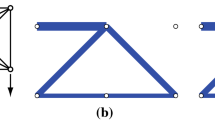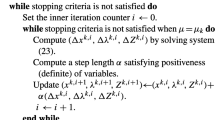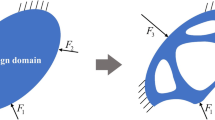Abstract
This paper addresses truss topology optimization taking into account robustness to uncertainty in the truss geometry. Specifically, the locations of nodes are assumed not to be known precisely and the compliance in the worst case is attempted to be minimized. We formulate a semidefinite programming problem that serves as a safe approximation of this robust optimization problem. That is, any feasible solution of the presented semidefinite programming problem satisfies the constraints of the original robust optimization problem. Since a semidefinite programming problem can be solved efficiently with a primal-dual interior-point method, we can find a robust truss design efficiently with the proposed semidefinite programming approach. A notable property of the proposed approach is that the obtained truss is guaranteed to be stable. Numerical experiments are performed to illustrate that the optimal truss topology depends on the magnitude of uncertainty.













Similar content being viewed by others
Notes
References
Achtziger W, Kočvara M (2007) Structural topology optimization with eigenvalues. SIAM J Optim 18:1129–1164
Anjos MF, Lasserre JB (eds) (2012) Handbook on semidefinite, conic and polynomial optimization. Springer, New York
Asadpoure A, Tootkaboni M, Guest JK (2011) Robust topology optimization of structures with uncertainties in stiffness—application to truss structures. Comput Struct 89:1131–1141
Bendsøe MP, Sigmund O (2004) Topology optimization: theory, methods and applications. Springer, Berlin
Ben-Haim Y (2006) Information-gap decision theory: decisions under severe uncertainty, 2nd edn. Academic Press, London
Ben-Tal A, El Ghaoui L, Nemirovski A (2009) Robust Optimization. Princeton University Press, Princeton
Ben-Tal A, Nemirovski A (1997) Robust truss topology optimization via semidefinite programming. SIAM J Optim 7:991–1016
Ben-Tal A, Nemirovski A (1998) Robust convex optimization. Math Oper Res 23:769–805
Beyer H-G, Sendhoff B (2007) Robust optimization—a comprehensive survey. Comput Methods Appl Mech Eng 196:3190–3218
Boyd S, El Ghaoul L, Feron E, Balakrishnan V (1987) Linear matrix inequalities in system and control theory. SIAM, Philadelphia
Brittain K, Silva M, Tortorelli DA (2012) Minmax topology optimization. Struct Multidiscip Optim 45:657–668
Calafiore GC, Dabbene F (2008) Optimization under uncertainty with applications to design of truss structures. Struct Multidiscip Optim 35:189–200
Calafiore G, El Ghaoui L (2004) Ellipsoidal bounds for uncertain linear equations and dynamical systems. Autom 40:773–787
Chen S, Chen W (2011) A new level-set based approach to shape and topology optimization under geometric uncertainty. Struct Multidiscip Optim 44:1–18
Cherkaev E, Cherkaev A (2003) Principal compliance and robust optimal design. J Elast 72:71–98
Cherkaev E, Cherkaev A (2008) Minimax optimization problem of structural design. Comput Struct 86:1426–1435
de Gournay F, Allaire G, Jouve F (2008) Shape and topology optimization of the robust compliance via the level set method. ESAIM: Control, Optimisation and Calculus of Variations 14:43–70
El Ghaoui L, Oustry F, Lebret H (1998) Robust solutions to uncertain semidefinite programs. SIAM J Optim 9:33–52
Elishakoff I, Haftka RT, Fang J (1994) Structural design under bounded uncertainty—optimization with anti-optimization. Comput Struct 53:1401–1405
Ganzerli S, Pantelides CP (2000) Optimum structural design via convex model superposition. Comput Struct 74:639–647
Guest JK, Igusa T (2008) Structural optimization under uncertain loads and nodal locations. Comput Methods Appl Mech Eng 198:116–124
Guo X, Bai W, Zhang W, Gao X (2009) Confidence structural robust design and optimization under stiffness and load uncertainties. Comput Methods Appl Mech Eng 198:3378–3399
Guo X, Du J, Gao X (2011) Confidence structural robust optimization by non-linear semidefinite programming-based single-level formulation. Int J Numer Methods Eng 86:953–974
Guo X, Zhang W, Zhang L (2013) Robust structural topology optimization considering boundary uncertainties. Comput Methods Appl Mech Eng 253:356–368
Horn RA, Johnson CR (1985) Matrix Analysis. Cambridge University Press, Cambridge
Jalalpour M, Guest JK, Igusa T (2013) Reliability-based topology optimization of trusses with stochastic stiffness. Struct Saf 43:41–49
Jalalpour M, Igusa T, Guest JK (2011) Optimal design of trusses with geometric imperfections: accounting for global instability. Int J Solids Struct 48:3011–3019
Jang G-W, van Dijk NP, van Keulen F (2012) Topology optimization of MEMS considering etching uncertainties using the level-set method. Int J Numer Methods Eng 92:571–588
Jansen M, Lombaert G, Diehl M, Lazarov BS, Sigmund O, Schevenels M (2013) Robust topology optimization accounting for misplacement of material. Struct Multidiscip Optim 47:317–333
Jarre F (2000) An interior method for nonconvex semidefinite programs. Optim Eng 1:347–372
Kanno Y, Guo X (2010) A mixed integer programming for robust truss topology optimization with stress constraints. Int J Numer Methods Eng 83:1675–1699
Kanno Y, Takewaki I (2006) Sequential semidefinite program for robust truss optimization based on robustness functions associated with stress constraints. J Optim Theory Appl 130:265–287
Kanno Y, Takewaki I (2008) Semidefinite programming for uncertain linear equations in static analysis of structures. Comput Methods Appl Mech Eng 198:102–115
Kanno Y, Takewaki I (2009) Semidefinite programming for dynamic steady-state analysis of structures under uncertain harmonic loads. Comput Methods Appl Mech Eng 198:3239–3261
Kanzow C, Nagel C, Kato H, Fukushima M (2005) Successive linearization methods for nonlinear semidefinite programs. Comput Optim Appl 31:251–273
Kuznetsov EN (1988) Underconstrained structural systems. Int J Solids Struct 24:153–163
Lazarov BS, Schevenels M, Sigmund O (2012a) Topology optimization considering material and geometric uncertainties using stochastic collocation methods. Struct Multidiscip Optim 46:597–612
Lazarov BS, Schevenels M, Sigmund O (2012b) Topology optimization with geometric uncertainties by perturbation techniques. Int J Numer Methods Eng 90:1321–1336
Lombardi M (1998) Optimization of uncertain structures using non-probabilistic models. Comput Struct 67:99–103
Noll D, Torki M, Apkarian P (2004) Partially augmented Lagrangian method for matrix inequality constraints. SIAM J Optim 15:161–184
Ohsaki M, Fujisawa K, Katoh N, Kanno Y (1999) Semi-definite programming for topology optimization of trusses under multiple eigenvalue constraints. Comput Methods Appl Mech Eng 180:203–217
Pantelides CP, Ganzerli S (1998) Design of trusses under uncertain loads using convex models. J Struct Eng (ASCE) 124:318–329
Pellegrino S (1993) Structural computations with the singular value decomposition of the equilibrium matrix. Int J Solids Struct 30:3025–3035
Pellegrino S, Calladine CR (1986) Matrix analysis of statically and kinematically indeterminate frameworks. Int J Solids Struct 22:409–428
Pólik I (2005) Addendum to the SeDuMi user guide: version 1.1. Technical report, Advanced optimization laboratory. McMaster University, Hamilton. http://sedumi.ie.lehigh.edu/
Pólik I, Terlaky T (2007) A survey of S-lemma. SIAM Rev 49:371–418
Schevenels M, Lazarov BS, Sigmund O (2011) Robust topology optimization accounting for spatially varying manufacturing errors. Comput Methods Appl Mech Eng 200:3613–3627
Schuëller GI (2006) Developments in stochastic structural mechanics. Arch Appl Mech 75:755–773
Schuëller GI, Jensen HA (2008) Computational methods in optimization considering uncertainties—An overview. Comput Methods Appl Mech Eng 198:2–13
Shapiro A (1997) First and second order analysis of nonlinear semidefinite programs. Math Program 77:301–320
Sigmund O (2009) Manufacturing tolerant topology optimization. Acta Mech Sinica 25:227–239
Steele JM (2004) The Cauchy–Schwarz master class: an introduction to the art of mathematical inequalities. Cambridge University Press, Cambridge
Sturm JF (1999) Using SeDuMi 1.02, a MATLAB toolbox for optimization over symmetric cones. Optim Meth Softw 11/12:625–653
Takezawa A, Nii S, Kitamura M, Kogiso N (2011) Topology optimization for worst load conditions based on the eigenvalue analysis of an aggregated linear system. Comput Methods Appl Mech Eng 200:2268–2261
Tarnai T (2001) Infinitesimal and finite mechanisms. In: Pellegrino S. (ed) Deployable Structures. Springer, Wien, pp 113–142
Wang F, Lazarov BS, Sigmund O (2011) On projection methods, convergence and robust formulations in topology optimization. Struct Multidiscip Optim 43:767–784
Wolkowicz H., Saigal R., Vandenberghe L. (eds) (2000) Handbook on semidefinite programming: theory, algorithms and applications. Kluwer Academic Publishers, Boston
Yamashita H, Yabe H (2012) Local and superlinear convergence of a primal-dual interior point method for nonlinear semidefinite programming. Math Program 132:1–30
Yonekura K, Kanno Y (2010) Global optimization of robust truss topology via mixed integer semidefinite programming. Optim Eng 11:355–379
Zang C, Friswell MI, Mottershead JE (2005) A review of robust optimal design and its application in dynamics. Comput Struct 83:315–326
Acknowledgements
The work of the second author is partially supported by Grant-in-Aid for Scientific Research (C) 26420545 from the Japan Society for the Promotion of Science.
Author information
Authors and Affiliations
Corresponding author
Appendix: Technical lemmas
Appendix: Technical lemmas
This section summarizes technical prerequisites that are known in literature.
We begin with three lemmas related to vector and matrix norms. These lemmas are used in Section 3.2. For p satisfying 1 ≤ p ≤ ∞, define p ∗ by
where we use the convention 1/∞ = 0. The ℓ p ∗-norm is the dual norm of the ℓ p -norm. For any x, \(\boldsymbol {y} \in \mathbb {R}^{n}\), we have that
which is known as the Hölder inequality (Horn and Johnson 1985; Steele 2004). For any \({\boldsymbol {x}} \in \mathbb {R}^{n}\), there exists \({\boldsymbol {y}} \in \mathbb {R}^{n}\) satisfying (64) with equality and ∥y∥ p ∗=1. We denote this y by ψ p (x).
Lemma 4
Let \(\mathbb {R} \ni s \ge 0\) be a constant, \({\boldsymbol {x}}\in {\mathbb {R}}^{n}\) and 1 ≤ p ≤ ∞. Then
Proof
For any \({\boldsymbol {x}}\in {\mathbb {R}}^{n}\) and \({\boldsymbol {y}}\in {\mathbb {R}}^{n}\) satisfying ∥y∥ p ∗ ≤ s, it follows from the Hölder inequality that
Here, two inequalities are satisfied with equalities at y = s ψ p (x), which concludes the proof. □;
Lemma 4 is used in the proof of Theorem 1 in Section 3.2.
Lemma 5
Let \(x \in \mathbb {R}\) , \({\boldsymbol {y}} \in \mathbb {R}^{n}\) and \(\mathbb {R} \ni r > 0\) . Then
Proof
The Cauchy–Schwarz inequality implies
From ∥z∥2 ≤ r, we obtain
These inequalities are satisfied with equalities at
which concludes the proof. □;
Lemma 5 is used in the proof of Theorem 1 in Section 3.2.
For \(A \in \mathbb {R}^{m \times n}\), the matrix norm induced by the Euclidean vector norm is defined by
which is equal to the largest singular value of A. From this definition we immediately obtain the following property.
Lemma 6
Let \(A\in {\mathbb {R}}^{m \times n}\) and \({\boldsymbol {x}}\in {\mathbb {R}}^{n}\) . Then
Lemma 6 is used to show Lemma 1 in Section 3.2.
In the following we establish Lemma 9, which is used in Section 3.2 to formulate the conservative approximation of the robust optimization problem. Two lemmas, Lemma 7 and Lemma 8, prepare for Lemma 9. Firstly, we state the following fact, which is the obvious part of the well-known S-lemma; see, e.g., Boyd et al. (1987) and Pólik and Terlaky (2007).
Lemma 7
Let f 0 , \(f_{1},\dots ,f_{m}:\mathbb {R}^{n} \to \mathbb {R}\) be quadratic functions. The implication
holds if there exist t 1 ,…,t m ≥ 0 satisfying
Proof
Suppose that (66) does not hold, which means that there exists \(\hat {{\boldsymbol {x}}} \in \mathbb {R}^{n}\) satisfying
Then we obtain
Thus the contraposition of Lemma 7 has been shown. □;
The following fact can be found, e.g., in Calafiore and El Ghaoui (2004).
Lemma 8
Let \(Q\in {\mathcal {S}^{n}}\) , \({\boldsymbol {p}}\in {\mathbb {R}}^{n}\) and \(r\in {\mathbb {R}}\) . Then the following two conditions are equivalent:
Proof
It is trivial that (ii) implies (i). We show that (i) implies (ii) by contradiction. Suppose that (ii) does not hold, which means that there exists \((\hat {\xi }, \hat {{\boldsymbol {x}}}) \in \mathbb {R} \times \mathbb {R}^{n}\) satisfying
If \(\hat {\xi } \not = 0\), then (69) is reduced to
which contradicts with (i). Hence, suppose \(\hat {\xi }=0\). Then (69) is reduced to
Let \(\gamma \in \mathbb {R}\) be a parameter and choose \({\boldsymbol {x}} = \gamma \hat {{\boldsymbol {x}}}\) in (i) to reduce the left-hand side to
The left-hand side of (71) is a quadratic function of γ and (70) implies that (71) is not bounded below. Therefore, there exists γ such that (71) becomes negative, which contradicts (i). □;
The following fact is obtained as a straightforward corollary of Lemma 7 and Lemma 8.
Lemma 9
Let f 0 , \(f_{1},\dots ,f_{m} : \mathbb {R}^{n} \to \mathbb {R}\) be quadratic functions defined by
where \({Q}_{i} \in {\mathcal {S}}^{n}\) , \({\boldsymbol {p}}_{i} \in \mathbb {R}^{n}\) , \(r_{i} \in \mathbb {R}\,(i=0,1,\dots ,m)\) . Then the implication
holds if there exist t 1 ,…,t m ≥ 0 satisfying
Lemma 9 plays a key role in proving Theorem 1 in Section 3.2.
Rights and permissions
About this article
Cite this article
Hashimoto, D., Kanno, Y. A semidefinite programming approach to robust truss topology optimization under uncertainty in locations of nodes. Struct Multidisc Optim 51, 439–461 (2015). https://doi.org/10.1007/s00158-014-1146-3
Received:
Revised:
Accepted:
Published:
Issue Date:
DOI: https://doi.org/10.1007/s00158-014-1146-3




